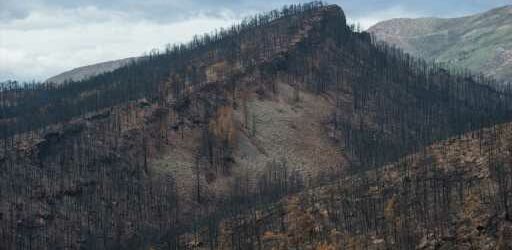Living in Colorado, we battle wildfires every year. Hundreds of thousands of acres of trees and bushes are charred to ash in 2020 alone.
When the summer rains come and fall on those burnt areas, the water, instead of soaking into the ground like normal, will simply run on top of the ash and hardened ground, collecting everything in its path as it slides down a mountainside.
The forecast for Thursday and Friday shows some concerning details for Colorado burn scars as rain showers and thunderstorms that form will have very little movement to them.
“A few storms that produce 1 to 2 inches of rain in 1 to 2 hours are likely, which would cause significant flooding if that occurred over the burn areas,” the National Weather Service in Boulder said, referring to storms in the central and northern mountains and the Front Range.
The type of setup we are entering is reminiscent of a monsoon weather pattern where a shift in our winds brings moisture to Colorado from the Gulf of Mexico and the eastern Pacific Ocean. Normally, the topography in Colorado is sufficient enough to produce showers and storms daily but what we lack here is adequate moisture so when you add moisture into the equation the chances of seeing rain increases greatly.
Thursday and Friday look especially wet with the presence of sufficient moisture but additionally, a decent chunk of upper-level energy will traverse the Rockies from Utah to Kansas that will provide additional lift for any storms to work with.
What this means, is that across Colorado on Thursday and Friday, enough variables are in place for rain showers and storms to become widespread and the possibility of those storms producing heavy, flooding rains is elevated. This is overall very good news for Colorado as an increase in humidity and moisture means that fire conditions will be suppressed and rains that fall west of the Continental Divide will provide local areas with much-needed drought relief.
However, the downside to this setup is that storm motions will be very slow at times meaning that rain can add up very quickly creating the concern for flash flooding and urban flooding. As we saw over the past few days, mudslides have wreaked havoc on Interstate 70 through Glenwood Canyon thanks to flooding that occurred over the Grizzly Creek fire’s burn scar and with the current forecast, as it stands, more scenes like this could be imagined in the canyon and other burned areas of the state.
“Steering flows are forecast to be weak, with slow storm motions expected. Given the abundant moisture and upslope flow, storms will be extremely efficient precipitation producers, and flash flooding on area burn scars will be high on both days,” the NWS in Pueblo said.
Burn scar flooding is a very serious concern and one that we have had to battle over the years, so take these threats seriously.
If you are planning on driving through the Glenwood Canyon, it’s best to check ahead with the forecast. If a flash flood warning is issued by the NWS for that chunk of the I-70 corridor, you can expect more closures and delays.
If you are out and about hiking over the next few days, flash flooding is a moderate to high threat so stay alert. If you are caught in a low-lying area when it is raining, it is advised to climb to safety. Even if it is raining lightly in your area, surrounding areas may be seeing heavier rainfall rates and all of that water has to go somewhere.
The forecast clears up slightly for the upcoming weekend as drier air moves in but rain chances won’t completely go away through early next week so keep in mind that rain and thunderstorms will be a possibility all weekend long.
It will be obvious where burn scars are. Just look for charred landscapes and little to no green growth — or very young vegetation. There have been wildfires in every corner of the state and regardless of if a fire happened recently or not, burn scar flooding can be an issue for many years after a wildfire occurred.
The Cameron Peak, East Troublesome, Pine Gulch, Calwood and Williams Fork burn scars are just a few of the areas to watch extra close this season.
Source: Read Full Article




